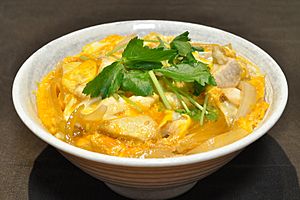Oyakodon facts for kids
Oyakodon (親子丼) (pronounced Oh-yah-koh-don) is a popular Japanese meal. Its name means "parent-and-child donburi." This is because it uses both chicken (the parent) and egg (the child) in the same dish!
It's a type of donburi, which means "rice bowl dish." To make Oyakodon, chicken, egg, and sliced scallions (or onions) are cooked together. They simmer in a tasty sauce made from soy sauce and a special broth. All of this delicious mix is then served on top of a big bowl of warm rice.
The Story Behind Oyakodon
The exact beginning of Oyakodon isn't fully known. However, the words "oyako" and "don" together first appeared in a newspaper ad. This ad was for a restaurant in Kobe, Japan, back in 1884.
The advertisement mentioned dishes like oyakojōdon, oyakonamidon, and oyakochūdon. These names might have referred to different sizes of the dish.
Different Kinds of Oyakodon
Japanese chefs love to play with the "parent-and-child" idea of Oyakodon. They have created other dishes that are similar but use different ingredients.
- Tanindon: This dish is called Tanindon (他人丼), which means "stranger bowl." It's made just like Oyakodon, but instead of chicken, it uses beef or pork.
- Sake Oyakodon: This version is called sake oyakodon (鮭親子丼), or "salmon parent-child donburi." It features fresh salmon and salmon roe (fish eggs). These ingredients are served raw over rice, creating a different kind of "parent and child" meal.
Images for kids
See also
 In Spanish: Oyakodon para niños
In Spanish: Oyakodon para niños





